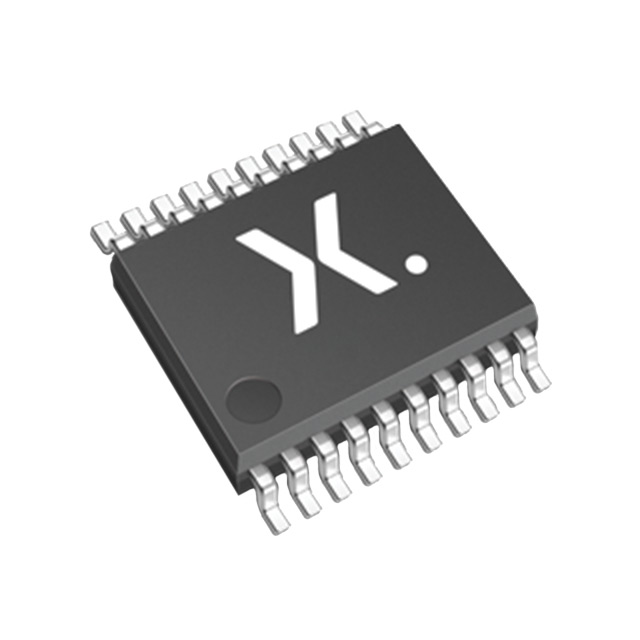Lihat spesifikasi untuk detail produk.

74LVC2244APW,118
Basic Information Overview
- Category: Integrated Circuit (IC)
- Use: Buffer/Line Driver
- Characteristics:
- Low-voltage CMOS technology
- High-speed operation
- Wide operating voltage range
- Schmitt-trigger inputs for noise immunity
- Package: TSSOP (Thin Shrink Small Outline Package)
- Essence: This IC is designed to provide buffering and line driving capabilities in various electronic circuits.
- Packaging/Quantity: Available in tape and reel packaging with 2500 units per reel.
Specifications
- Supply Voltage Range: 1.2V to 5.5V
- Input Voltage Range: 0V to VCC
- Output Voltage Range: 0V to VCC
- Operating Temperature Range: -40°C to +125°C
- Input Capacitance: 3.5pF
- Output Capacitance: 3.5pF
- Propagation Delay Time: 3.8ns (typical)
- Output Current: ±24mA
Detailed Pin Configuration
The 74LVC2244APW,118 IC has a total of 20 pins arranged as follows:
___________
| |
1A |1 20| VCC
2A |2 19| 4A
1Y |3 18| 4Y
2Y |4 17| GND
1B |5 16| 4B
2B |6 15| 3B
1Y |7 14| 3Y
2Y |8 13| 3A
1G |9 12| 2A
2G |10 11| 2Y
|___________|
Functional Features
- The 74LVC2244APW,118 is a non-inverting octal buffer/line driver with 3-state outputs.
- It operates at high speed and can drive heavy loads while maintaining signal integrity.
- The Schmitt-trigger inputs provide noise immunity and allow for reliable operation in noisy environments.
- This IC is compatible with both TTL and CMOS logic levels, making it versatile in various applications.
Advantages and Disadvantages
Advantages: - Wide operating voltage range allows compatibility with different power supply systems. - High-speed operation enables efficient data transmission. - Schmitt-trigger inputs enhance noise immunity, ensuring reliable performance. - 3-state outputs provide flexibility in controlling bus lines.
Disadvantages: - Limited output current may restrict its use in certain high-current applications. - The TSSOP package may require careful handling during assembly to avoid damage.
Working Principles
The 74LVC2244APW,118 functions as a buffer/line driver by amplifying and shaping input signals. It uses low-voltage CMOS technology, which allows for operation at lower power supply voltages. The Schmitt-trigger inputs ensure that the output transitions occur at well-defined voltage levels, even in the presence of noise or signal degradation.
When an input signal is applied, the IC amplifies and drives the signal to the corresponding output pin. The 3-state outputs provide the ability to disconnect the output from the bus line, allowing multiple devices to share the same bus without interference.
Detailed Application Field Plans
The 74LVC2244APW,118 is commonly used in various electronic systems, including:
- Microcontrollers and microprocessors
- Data communication systems
- Industrial automation equipment
- Automotive electronics
- Consumer electronics
In microcontroller applications, this IC can be used to buffer and drive signals between the microcontroller and other peripheral devices. In data communication systems, it helps in signal conditioning and level shifting tasks. Industrial automation equipment often requires reliable signal buffering for control and monitoring purposes, where the 74LVC2244APW,118 proves useful. Automotive electronics utilize this IC for various signal driving requirements. Lastly, consumer electronics such as TVs, audio systems, and gaming consoles benefit from its buffering capabilities.
Detailed and Complete Alternative Models
- SN74LVC2244A: Similar octal buffer/line driver IC from Texas Instruments.
- MC74LVC2244A: Octal non-inverting buffer/line driver IC from ON Semiconductor.
- CD74LVC2244A: CMOS octal buffer/line driver IC from Texas Instruments.
These alternative models offer similar functionality and characteristics, providing options for designers based on availability and specific requirements.
Word count: 550 words
Sebutkan 10 pertanyaan dan jawaban umum terkait penerapan 74LVC2244APW,118 dalam solusi teknis
Sure! Here are 10 common questions and answers related to the application of 74LVC2244APW,118:
Q: What is the function of the 74LVC2244APW,118? A: The 74LVC2244APW,118 is an octal buffer/line driver with 3-state outputs. It is used to amplify and buffer digital signals.
Q: What is the voltage range supported by the 74LVC2244APW,118? A: The 74LVC2244APW,118 supports a voltage range from 1.65V to 5.5V.
Q: How many channels does the 74LVC2244APW,118 have? A: The 74LVC2244APW,118 has 8 channels or buffers.
Q: What is the maximum output current of the 74LVC2244APW,118? A: The maximum output current per channel is 24mA.
Q: Can the 74LVC2244APW,118 be used for bidirectional communication? A: No, the 74LVC2244APW,118 is unidirectional and can only be used for one-way signal amplification.
Q: What is the propagation delay of the 74LVC2244APW,118? A: The typical propagation delay is around 4.5ns.
Q: Is the 74LVC2244APW,118 compatible with TTL logic levels? A: Yes, the 74LVC2244APW,118 is compatible with both TTL and CMOS logic levels.
Q: Can the 74LVC2244APW,118 be used in high-speed applications? A: Yes, the 74LVC2244APW,118 is designed for high-speed operation and can be used in such applications.
Q: What is the power supply voltage required for the 74LVC2244APW,118? A: The power supply voltage range is typically between 1.65V and 5.5V.
Q: Can the 74LVC2244APW,118 handle a wide temperature range? A: Yes, the 74LVC2244APW,118 is specified to operate over a temperature range of -40°C to +125°C.
Please note that these answers are general and may vary depending on the specific datasheet and manufacturer's specifications for the 74LVC2244APW,118.

